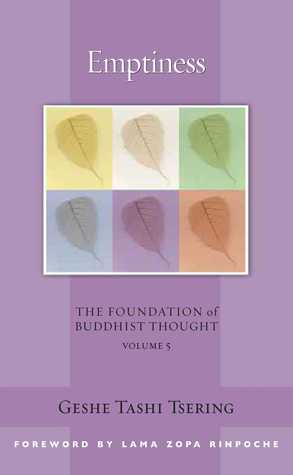Kindle Notes & Highlights
Read between
July 30, 2022 - April 30, 2025
Only when we start cherishing others will true happiness grow within us.
lacking insight into emptiness, the delusions will win.
When something strengthens this sense of a real “I,” we develop attachment for it, and conversely, when something threatens it, we develop aversion to it.
only by using consequential reasoning—where assertions are established by attacking a logical stance until it falls into absurdity—will the practitioner realize the final mode of existence of things and events, which is their lack of inherent or intrinsic existence.
Chandrakirti introduced the term empty of inherent existence, which is why he, rather than Buddhapalita, is considered the founder of the Prasangika subschool.
it is said that people whose predominant mental disposition is attachment should choose ugliness as the object of meditation, and people for whom it is anger should use love. People trapped in discursiveness and prone to distractions should meditate on the breath.
the Tibetan tradition of insight emphasizes the systematic use of logical statements, employing high degrees of concentration to bring conceptualized analysis to a degree that the mind cannot refute.
the four seals, the basic tenets of Buddhism. They are: 1. All compounded phenomena are impermanent. 2. All contaminated things are suffering. 3. All phenomena are selfless. 4. Nirvana is true peace.
No matter what kind of Buddhism you practice, no matter what level of understanding you hold, to be a Buddhist at least you need a conviction in the selflessness of phenomena.
The non-Mahayana schools (Vaibhashika and Sautrantika) explain that to achieve individual liberation, the antidote is the insight that realizes this level of the absence of self (as a self-sufficient, substantial reality).
Prasangika Madhyamaka argues that this notion of selfhood as self-sufficient, substantial reality is not the first of the twelve links of dependent origination, and hence is not the actual root of cyclic existence.
This third level of the notion of selfhood is the self as an intrinsic entity; the self exists within our five aggregates with some kind of intrinsic or inherent nature.
The non-Prasangika schools assert that, although it is constantly changing along with the aggregates that form its base, the self has some sort of intrinsic existence. Otherwise, it would be nothing more than a random appellation.
The concept of the emptiness of phenomena for the Chittamatra school is the absence of duality between subject and object.
According to the general Svatantrika view, things and events exist and are able to function in that they can bring results; they exist conventionally by way of their own character (Tib.
There is general agreement that the emptiness of phenomena is ultimate truth, but whether the selflessness of persons is ultimate truth is a huge debate.


